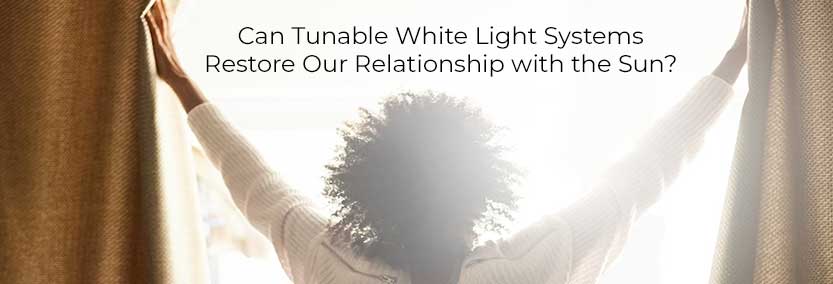PERFEKTLIGHT: Finding the Connection Between Tunable White and Circadian Lighting
Not all tunable white LED lighting systems are the same. LEDdynamics have developed a superior model that truly matches the light of the sun. Its name: PERFEKTLIGHT. To find out more, let’s explore how tunable white lighting works.
Tunable white lighting adjusts the color temperature of white light. When it’s set up to match the changing of the sun’s light through the day, this can have multiple benefits on our health. This is because it helps to restore our circadian rhythm, another name for our natural body clock.
Sunlight’s Affect on Human Physiology
If we had a perfect lifestyle, we would wake up every day at sunrise, and fall asleep when it gets dark. Our bodies are designed to do this: they produce melatonin, a natural sleep hormone, in reaction to darkness.
However, in our modern world, we have disrupted this process completely. Most notable, we often substitute natural daylight with artificial light. Fortunately, artificial light can now replicate the behavior of sunlight, allowing us to restore our circadian rhythms.

Sunlight Replicated Using Electric Lighting

SPD of natural daylight & sunset – NOTE DAYLIGHT peak at 482nm
Replicating sunlight using electric light poses certain challenges. To appreciate these, we need to understand something called the Spectral Power Distribution (SPD) of sunlight. SPD describes the power of light at a given wavelength. Daylight SPD is rich in blue, but changes throughout the day and as the afternoon draws in it progresses to red. SPD and its progression through the day is extremely important to our circadian rhythms.
Recently, scientists have proven that our eyes contain a non-visual ipRGC (intrinsically photosensitive retinal ganglion cell) receptor, which is most sensitive to blue light at 482 nanometers. During the day, sunlight provides a high level of this blue wavelength. The blue blocks melatonin production, helping improve alertness and productivity. Then, as the afternoon progresses, the sun’s SPD drops in blue and shifts to red, helping kick-start the sleep cycle.
Typical White LEDs & Blue-light Issue

Daylight versus LED – NOTE BLUE spike at 450nm and trough at 482nm
However, the blue color in the SPD of most LED lights is very different to that of sunlight. This is because of a phosphor coating placed upon blue LEDs.
Most tunable white systems can emulate the visible shift in color temperature of sunlight, but due to the blue spike (see image on right), fail to offer the non-visual light important to circadian rhythm. They wind up either suppressing melatonin too little during the day, or creating an uncomfortable setting high in glare and brightness.
To suppress melatonin during the day with a neutral-white light, the space would need to be over-lit, creating a glare that makes people uncomfortable. Using a cool-white LED with appropriate light levels, could also make people uncomfortable because of the blue color temperature of 6500-Kelvin.
Because typical LEDs have a low SPD at 482nm, combining such LEDs in color tuning system fails to replicate sunlight and limits the system’s ability to promote a healthy circadian rhythm.
A New Solution

PERFEKTLIGHT uses high CRI Nichia Optisolis LEDs
It is now possible to create tunable white lighting systems that use the broadest SPD and phosphors that both present very high Color Rendering Index (CRI) and significantly reduce inappropriate blue light in morning and evening.
The Nichia’s Optisolis LEDs, which provides the highest CRI, can eliminate the trough at 482nm and should help suppress the overproduction of melatonin due to excessive blue light at 450nm.
PERFEKTLIGHT
Compared with typical white LEDs, Nichia’s Optisolis LEDs minimize the blue peak and fill in the trough in the SPD. Critically, the SPDs of these LEDs equal the SPD of sunlight. Consequently, this is done through combining warm-white and cool-white Optisolis lights. One more element is needed to make sure the light accurately tracks the sun’s daily progress. This is the addition of green light, which allows the light to fully match the Blackbody Locus (BBL). The BBL is the curve that defines white light within the color space. Through combining Optisolis LEDs with the green correction, we created PERFEKTLIGHT. Its name comes from the fact that it matches the sun’s behavior perfectly.

SPD of PERFEKTLIGHT – NOTE low blue light level of warm color temperature for morning and evening versus the higher blue light level of neutral and cool-white color temperatures during daytime
PERFEKTLIGHT is the tunable lighting system that truly matches our natural circadian rhythm. Application software and “set and forget” controls allow the light to be preset to your exact geographical location.


